
A margarita is a cocktail consisting of tequila, triple sec, and lime juice. Some margarita recipes include simple syrup as well and are often served with salt on the rim of the glass. Margaritas can be served either shaken with ice, without ice, or blended with ice. Most bars serve margaritas in a stepped-diameter variant of a cocktail glass or champagne coupe called a margarita glass. The margarita is one of the world's most popular cocktails and the most popular tequila-based cocktail.

Anisette, or Anis, is an anise-flavored liqueur that is consumed in most Mediterranean countries. It is colorless and, because it contains sugar, is sweeter than dry anise flavoured spirits. The most traditional style of anisette is that produced by means of distilling aniseed, and is differentiated from those produced by simple maceration by the inclusion of the word distilled on the label. And while Pastis is a similar-tasting liqueur that is prepared in similar fashion and sometimes confused with anisette, it employs a combination of both aniseed and licorice root extracts. Sambuca is essentially an anisette of Italian origin that requires a high minimum (350g/L) sugar content.

Chartreuse is a French herbal liqueur available in green and yellow versions that differ in taste and alcohol content. The liqueur has been made by Carthusian monks since 1737 according to instructions set out in a manuscript given to them by François Annibal d'Estrées in 1605. It was named after the monks' Grande Chartreuse monastery, located in the Chartreuse Mountains north of Grenoble. Today the liqueur is produced in their distillery in nearby Aiguenoire. It is composed of distilled alcohol aged with 130 herbs, plants and flowers.
Apéritifs and digestifs are drinks, typically alcoholic, that are normally served before (apéritif) or after (digestif) a meal respectively.

Advocaat or advocatenborrel is a traditional Dutch alcoholic beverage made from eggs, sugar, and brandy. The rich and creamy drink has a smooth, custard-like consistency. The typical alcohol content is generally between 14% and 20% ABV. Its contents may be a blend of egg yolks, aromatic spirits, sugar or honey, brandy, vanilla, and sometimes cream. Notable makers of advocaat include Warninks, Bols, Darna Ovo Liker, DeKuyper, and Verpoorten.

Becherovka, formerly Karlsbader Becherbitter, is a herbal bitters, often drunk as a digestif. It is produced in Karlovy Vary, Czech Republic by the Jan Becher company. The brand is owned by Pernod Ricard. It is made from a secret recipe based on more than twenty types of herbs and spices.
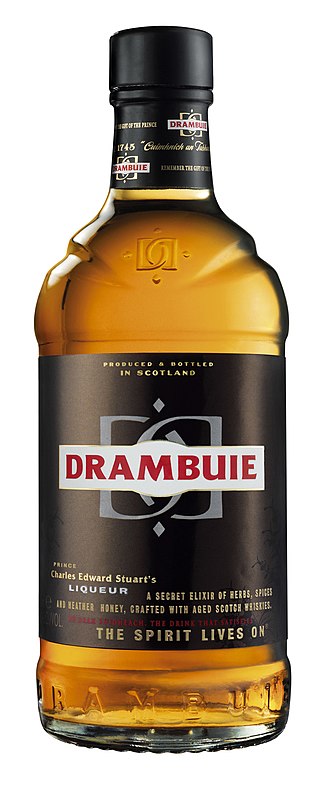
Drambuie is a golden-coloured, 40% ABV liqueur made from Scotch whisky, heather honey, herbs and spices. The brand was owned by the MacKinnon family for 100 years, and was bought by William Grant & Sons in 2014.

Bénédictine is a herbal liqueur produced in France. It was developed by wine merchant Alexandre Le Grand in the 19th century, and is flavored with twenty-seven flowers, berries, herbs, roots, and spices.
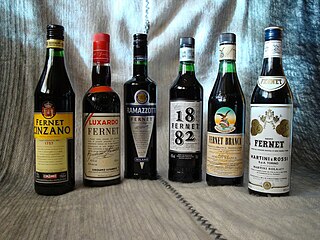
Fernet is an Italian type of amaro, a bitter, aromatic spirit. Fernet is made from a number of herbs and spices which vary according to the brand, but usually include myrrh, rhubarb, chamomile, cardamom, aloe, and especially saffron, with a base of distilled grape spirits.
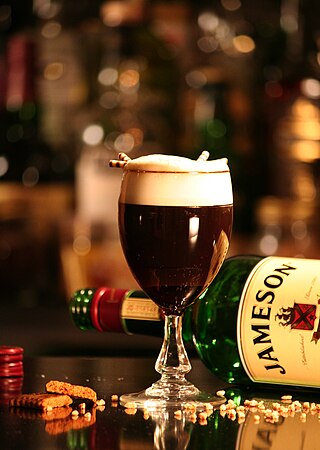
A liqueur coffee is a caffeinated alcoholic drink that consists of a shot of liqueur, mixed with coffee. It is typically served in a liqueur glass, often accompanied with cream and sugar. Coffee liqueur beverages are served in different fashions and can be found throughout many countries. One of the most popular liqueur coffee beverage is commonly known as Irish coffee. Liqueur coffee beverages are largely classified as cocktails as well as digestifs which are aimed at aiding the digestive process typically after a meal.
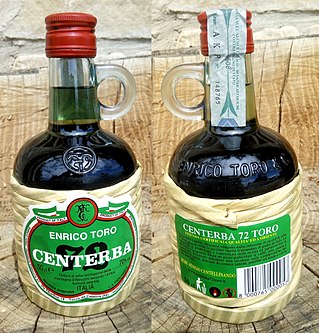
Centerbe or Centerba, is a liqueur made by aromatic herbs commonly found on Mount Majella. It is a typical abruzzese liquor in central Italy and it's made on a base of 70% alcohol. The liqueur comes in two strengths: strong and mild. The strong centerba is widely used as digestif after-meals and has antiseptic properties. It was originally manufactured by Beniamino Toro in Tocco da Casauria in 1817.

Génépi or génépy is a traditional French herbal liqueur or aperitif popularized in the Alpine regions. Genepi also refers to alpine plants of the genus Artemisia that is used to make a liqueur in the French region of Savoy where the Artemisia genepi plants grow and where the beverage is commonly produced.
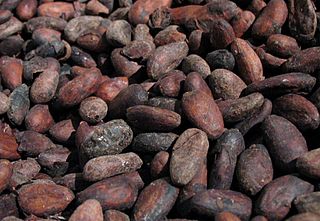
Chocolate liqueur is a chocolate flavored liqueur made from a base liquor of whisky or vodka. Unlike chocolate liquor, chocolate liqueur contains alcohol. Chocolate liqueur is often used as an ingredient in mixology, baking, and cooking.
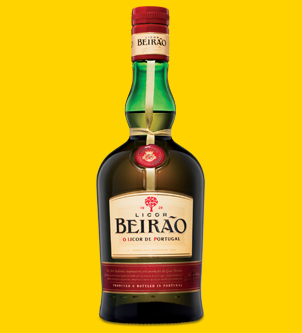
Licor Beirão, commonly simply known as Beirão, is a Portuguese liqueur from the Beira region of Portugal. Originating in the 19th century, it is the most consumed alcoholic spirit in Portugal.

Amaro Averna is an Italian liqueur in the Amaro category produced in Caltanissetta, Italy. It is named after its inventor, Salvatore Averna, who invented the recipe in 1868. This drink is produced on the Island of Sicily and is considered a traditional drink. The Averna company was acquired in 2014 by Gruppo Campari.

Herbs de Majorca is a Majorcan herbal liqueur of medicinal origin. A form of the generic Hierbas, Herbs de Majorca has a protected designation of origin and can only be made in Majorca.

Schrobbelèr is a Dutch herbal liqueur, made by Jonkers Distillers B.V. (Tilburg). In the United States and Australia it is sold under the brand name Jans because English-speaking people have great difficulty with the pronunciation of the consonant sequence "schr".
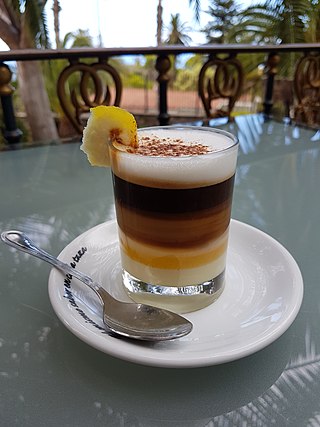
Barraquito is a coffee liqueur commonly available on Tenerife, also known as zaperoco.


















